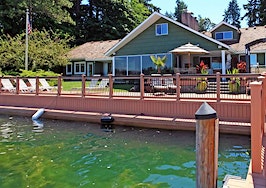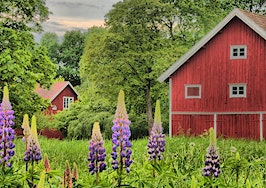- When working with clients on an equestrian property, real estate agents must have specific knowledge about what it takes to care for horses.
Ranging from modest homes with just enough land to house an aging family pony to multi-million dollar equestrian estates, few types of property require such a specific field of knowledge including equine health care, safety, state liability laws and pasture management.
Most clients looking to have their horses on their own property usually have a pretty good idea of what they want. Most first-time equestrian property buyers already own at least one horse, if not more than one, and they are currently paying to keep their four-legged friend at someone else’s facility.
For any number of reasons, these owners have decided they want to move somewhere where their horse can live with them.
Many horse farm buyers have dreamed of the day they could wake up, make a cup of coffee and go out and care for their own horse. This is a very emotional and exciting process for them, and they will have done lots of research.
Some buyers may even bring their friends, trainers or veterinarians out to see a property before putting in an offer.
The top concerns of the average horse property buyer are for the horse’s health, safety and well-being rather than their own comfort.
Taking care of horses is a full-time job in itself. It never fails to amaze me how difficult it can be to keep a horse healthy, sound and happy, and I’ve been caring for horses for over 35 years.
Whoever came up with the saying “healthy as a horse” never owned one, as few animals are as accident and illness prone as the average horse.
So when marketing the listing toward potential equestrian use, there is a lot that goes into deciding if the property really is suited for horses.
Here is my top 10 list of what you need to know about buying and selling an equestrian property.
1. Know the land
Not all land is conducive to horse keeping — steep slopes, heavily wooded areas and marshy areas consisting of poorly draining soil are all inadvisable qualities in a horse facility.
Steep slopes put undue strain on delicate tendons and ligaments, sharp tree branches are all reaching out to scratch unprotected eyes and soupy soil can cause hoof walls to rot and weaken.
Very rocky soil can cause bruising to tender soles of the hooves and stress and crack hoof walls. Farms with standing water can be breeding grounds for mosquitoes that can transmit potentially fatal equine diseases.
Do your research, and also find out if the property is going to have adequate water for equine needs. The average horse drinks five to 10 gallons of water per day, so having a deep well with high yield will come in handy filling 150 gallon troughs.
Also, know where the “after effects” of all the grass, water and grain a horse eats is going to go. The average 1,000-pound horse gives off 37 pounds of manure and 2.4 gallons of urine a day.
If there isn’t one already there, have an idea where the most convenient place to put a manure pile will be that fits into local zoning regulations, environmental regulations and potential HOA regulations.
2. Is that a bank barn, pole barn or shed row?
Just as there are different styles of homes, there are different styles of barns. Is there a loft with hay storage? If yes, how many bales does it hold? How many stalls are in there, and is there room for storage or equipment?
Also, in the pastures, are there structures, usually called run-in sheds for the horses to escape beating sun, driving rain or get out of winter winds?
Especially if there is no barn on the property, horses must have some form of shelter to protect them from extreme weather conditions.
3. Where do I keep my tack?
Horse people have a lot of equipment for the care and riding of their horses, and this all needs to be kept somewhere, usually called a tack room. This is where saddles, bridles, blankets, grooming supplies and more are kept.
It is not unusual for a saddle to be $2,000 – $4,000, so tack storage areas need to be secure from not only the possibility of theft but also the potential ravages of critters.
Mice leave behind droppings, make a mess and can chew through delicate stitching and weaken leather.
A tack room should be protected from extremes in temperature, which can also weaken and damage leather goods.
Many riders keep first aid supplies and medications in the barn, and all medications should be kept in temperature-controlled areas to prevent spoiling of the active ingredients.
4. Why do I need a feed room?
Horses love to eat. If it were up to them, they would eat all day, and most of the night, too. The equine animal is designed to graze and eat slowly and steadily throughout the day.
One of the most frightening scenes to find first thing in the morning is a horse that has somehow gotten into a feed room and gorged on grain.
As humans, if we eat something that may have gone bad, or overeat and get a stomach ache, we may throw up and then feel better.
Horses are not physically able to vomit. This can lead to an episode of colic, or severe stomach pain, and can be fatal. A horse-proof place to store grain is a must. Ideally, the storage should also be rodent proof, as well.
5. Check the fences
My in-laws live down the street from a beautiful horse property that was lovely in every way — except the fences.
One night, their neighbor’s horse broke through the fence, was standing in the middle of the road and was hit by a speeding car. The horse was killed, and the driver of the vehicle was severely injured.
Fences must be strong, sturdy and checked regularly for loose nails, cracked boards or loose posts. Three- and four-board wood fences are the most common types, with electric tape, vinyl and no-climb wire also being popular.
Barbed wire should never be used on an equestrian property — some of the most gruesome injuries I have ever seen were when a horse got tangled in barbed wire and panicked.
6. Ride out?
This is one category that causes more problems for the listing agent than any of the others. Ride out is the term used by equestrians to denote if there are riding trails or areas off the property that are allowed for equestrian use.
I often see agents comment: “Miles of trails!” Unless there is a public park next door that allows equestrian use, do not say you can ride on other people’s property. With increased liability and fear of lawsuits, fewer and fewer private landowners are allowing people to ride on their properties.
The buyer is not going to be at all pleased if the first time they take Mr. Ed on a leisurely trail ride through their neighbor’s acreage they get shot at for trespassing.
7. Find out what the area surfaces are made of
Horses have incredibly delicate tendons and ligaments in their legs, and if they tear or rupture one, it can be a career ending, if not a fatal, injury. Because of this, it’s no surprise training surfaces, like in arenas, now have any number of options to cushion the impact of repeated stress.
From bluestone and sand to synthetic materials including rubber and felt, know what the surface is and how old it is.
Sand breaks down through repeated use and time and will need to be replaced. The synthetic materials can be very expensive and are a major selling point of a property to a serious competitor.
It’s not unusual for a complete arena installation to be between $50,000 and $100,000, or more. Arenas always deserve a mention along with upgraded footing — this alone can be a major selling point.
8. Is there access for vets, farriers and trailers?
Horses require a lot of people to keep them healthy. Farriers trim equine feet and attach shoes as needed every four to six weeks.
Veterinarians usually visit a minimum of twice a year for checkups and vaccines, and many horses also get at least a once yearly visit from the equine dentist.
Having a way for them to easily access your barn and then have a place that is well-lit to safely work, even potentially late at night, is a must.
Somehow, horses know the most inconvenient time to get sick — mine save up their sick time for 6 p.m. on the Friday before a major holiday weekend to have their most serious illnesses and injuries.
Not only do all of these people need a place to work on your horse, they also need a place to park their truck where they have easy access to the tools of their trade.
Having a dirt path to the barn that turns into eight inches of shoe-sucking mud during the spring rainy season will make for a very cranky veterinarian if they get their vehicle stuck at your farm.
Also, if owners plan to have feed and hay delivered, those very large heavy trucks need a way to get into the property and to the place where they need to deliver. If they don’t think they can get to your property without getting stuck, they won’t deliver.
9. Look for farm equipment storage and parking
You are also going to need a place to park all of your farm “toys.” Horse trailers, tractors, mowers, manure spreaders, trucks, arena maintenance equipment and whatever else you have all need a place to live.
Keeping machines covered or in some form of garage will make them last longer and work more reliably.
Some equipment, like a bush hog, will probably only be used a handful of times a year. These are the tools that can and will run forever if properly maintained and protected from the elements.
10. Figure out a bad weather plan
Every farm owner needs a plan for bad weather. Deciding to come up with a game plan for a snowstorm once the flurries begin is way too late.
If homeowners are in areas with wildfires, they need a plan for how to get their horses to safety. In areas that may flood, they may need to trailer their horses out to somewhere higher and drier well before the storm even begins.
If a huge snow is expected where they may be snowed in, they need a plan for how to get to their barn to feed and water the animals. If the barn is two miles from the house, they will need heavy equipment to make sure they can get to their horses in a timely manner.
By addressing these 10 key horse facility concerns in your marketing, you will be helping prospective buyers check off the must haves on their needs and wants list. If the property you are selling is coming up lacking in a certain category, have a plan for what could work for them instead.
For example, does your barn not have a feed room? No problem, be able to tell them where they can buy horse-proof feed bins to put in the extra wide aisle.
No existing tack room? Show the potential buyer where one could be added on after purchase, or maybe the buyer could turn an existing stall into storage instead.
Always remember a true horse person is going to want what is best for their horses.
By accentuating the reasons your listing is the home where every horse would want to live, you will draw potential buyers to your equine property like flies to a manure pile — or more poetically, flies to honey!
Maria Dampman is the owner and manager of Smiling Cat Farm and a Virginia State licensed Realtor and ABR with Century 21 Redwood in Leesburg, Virginia. Visit her on Facebook or LinkedIn.











